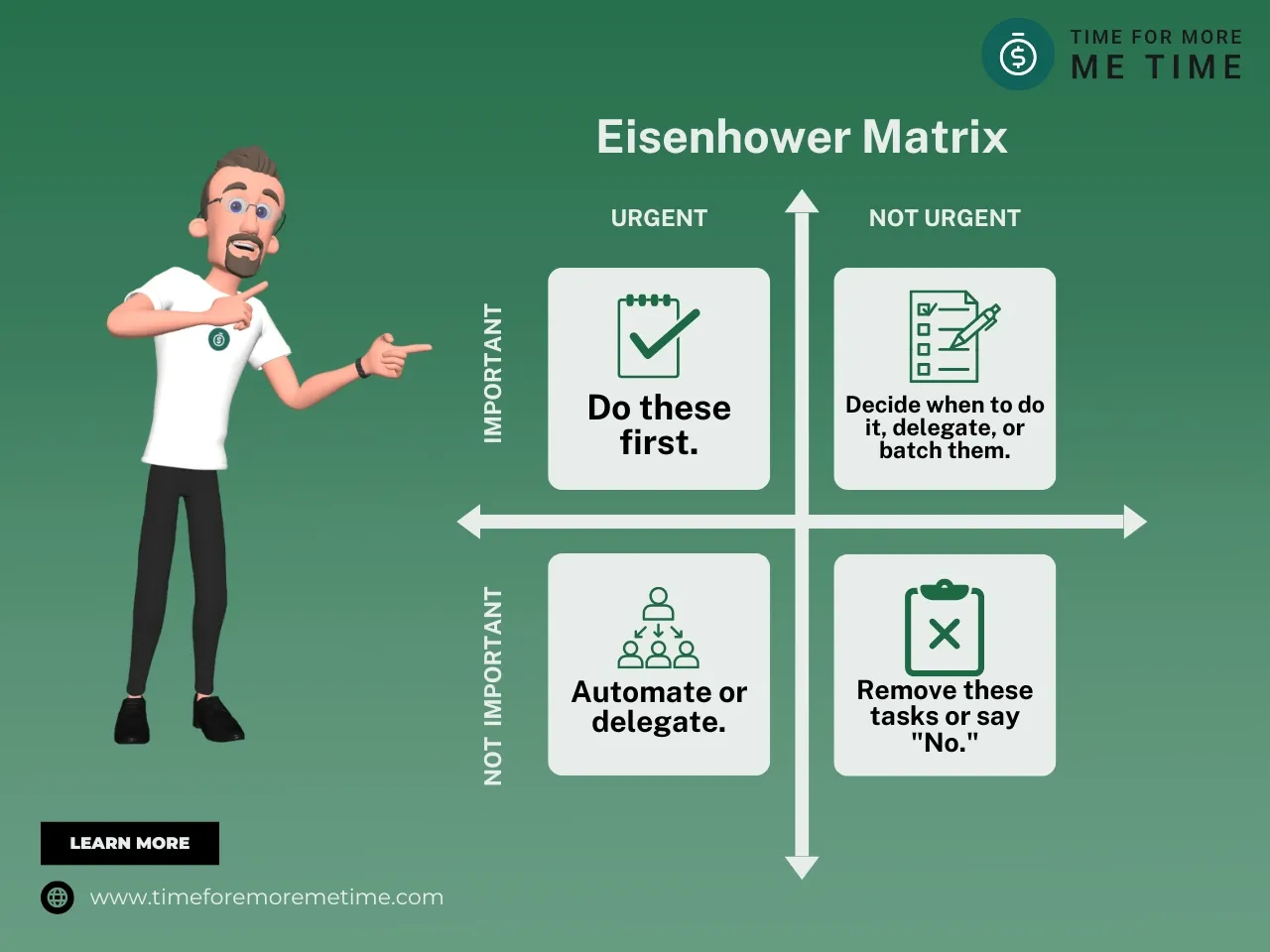
Do you ever wish there were more hours in the day? What if I told you that you don’t need the world to slow down—you just need to manage your time better? That’s where I come in, sharing some of the most game-changing time management techniques I know.
Learning them is easy, but doing them consistently is hard. It takes practice, discipline, and, well… time! I know this firsthand. It took me a while to get integrate these techniques and reap their benefits.
Back when I was earning my degrees—I unfortunately have three—I had to juggle my studies with side jobs—so managing my time effectively wasn’t optional, it was a necessity. After years of refining my approach, I’ve learned a thing or two about time management methods that really works.
Now, the tips for better time management I’m about to share aren’t your typical “just make a to-do list” advice. These are proven strategies—ones I’ve tested myself and learned from experts—that boost efficiency without sacrificing sleep. With them, you can say goodbye to procrastination and hello to real productivity.
So, are you ready to make every second count? Let me take the guesswork out of it with these powerful time management strategies—ones I’ve picked up through real-life experience and professional growth.
1. Timeboxing

Before anything else, what is time management? At its core, the definition of time management is the practice of consciously using your time efficiently to complete the most important tasks in the shortest amount of time and free up time to do something else.
With that said, one of my favorite time management techniques for boosting productivity is timeboxing. It may seem simple, but its impact is powerful—turning everyday tasks into wins.
The concept is straightforward: allocate a specific time slot for each task on your to-do list. Try setting 15 minutes for responding to emails, a couple of hours for a project, and five minutes for a quick break.
Set time limits and eliminate distractions. As the minutes tick by, something shifts—suddenly, you’re working faster, thinking clearer, and accomplishing more, reinforcing strong time management habits.
I’ve found timeboxing especially helpful for tasks I tend to procrastinate on. Knowing I have only a set amount of time to complete something keeps me focused and pushes me past any initial resistance.
2. Eisenhower Matrix

The Eisenhower Matrix is a powerful tool for improving time management. I approach my to-do list strategically, separating must-dos from might-dos based on urgency. This way, the most critical tasks stand out, while less pressing ones wait their turn.
Here’s how it works, step by step:
- List out all your tasks: Write down everything you need to do, big or small, without worrying about order. This gives you a full picture of what’s on your plate.
- Put urgent and important tasks in the first quadrant: These require immediate attention—think meeting deadlines, handling unexpected issues, or addressing high-priority work.
- Place important but not urgent tasks in the second quadrant: These are essential for long-term success but don’t need immediate action. Planning, skill-building, and setting goals belong here.
- Write down urgent but not important tasks in the third quadrant: These feel pressing but don’t contribute much to your goals—like responding to non-essential emails or sitting through unnecessary meetings.
- Leave non-urgent and non-important tasks in the fourth quadrant: This will be your “to-don’t list.” These are distractions that waste time, like mindless social media scrolling or watching cat videos.
If you feel like you’re constantly busy but not making progress, the Eisenhower Matrix can help. I use it to boost productivity and create a better balance between work and personal life.
3. Deep Work Sessions

Want to get stuff done? I’ve been there—juggling countless projects at once. It’s like trying to keep a dozen plates spinning while riding a unicycle. Staying focused and productive in that kind of chaos can feel like an uphill battle.
One of the most effective time management techniques I’ve discovered is deep work. If you haven’t heard of it, deep work is the practice of setting aside dedicated chunks of time to focus intensely on a single task—without any distractions.
And when I say no distractions, I mean it. No emails, no social media, no chatty coworkers—just you and the task at hand. It might sound a little extreme, but trust me, it works.
Feeling bold enough to tackle complex projects with confidence? Try this: time block your work sessions, especially for tasks that require deep focus. I swear by reserving a couple of morning hours for deep work when my brain is at its peak.
But here’s the key—you have to stick to it. No cheating, no checking your phone, and no getting sidetracked by other tasks. It takes discipline, but the payoff is huge. You’ll get things done in hours that would normally take days.
Start small. Try time-blocking just 30 minutes a day and gradually increase as you build the habit. And don’t forget to schedule breaks—your brain needs time to recharge between intense focus sessions.
By intentionally incorporating deep work into your routine, you’ll not only boost productivity but also transform the way you approach your daily tasks. It’s made a massive difference in my work life—maybe it can do the same for you.
4. Digital Detoxes

In today’s always-on, hyper-connected world, one of the best time management strategies for boosting productivity is a digital detox. Think about it—how often do we get caught up in the endless buzz of notifications, emails, and social media feeds?
Believe it or not, constantly drowning in digital noise doesn’t just drain our energy—it slowly chips away at our creativity and inner peace. That’s where the power of an old-fashioned digital detox comes in.
By stepping away from our devices and disconnecting from the online world, we give our minds the break they need to recharge and reset. This is the type of break I mentioned earlier—one that genuinely refreshes you.
I get it—the thought of going even a day without your phone might sound overwhelming. But trust me, the benefits are well worth it:
- Improved focus and concentration
- Lower stress and anxiety levels
- Better sleep quality
- More time for hobbies, relationships, and self-care
- A fresh perspective and renewed inspiration
Personally, I’ve found that taking a digital detox one day a week works wonders for my creativity. Go hiking, swimming, camping—anywhere with no signal. It’s a great way to spend time with nature and loved ones, hitting two birds with one stone.
Think you can’t do it? Let me share how I started.
Start small—try a half-day or full-day detox and gradually extend it. You’ll not only recharge but also sharpen your time management skills in the process.
To avoid worrying family and friends, give them a heads-up about your detox in advance. If you’re staying home, keep your phone and laptop out of sight to resist temptation.
After your detox, take a moment to reflect on how you feel.
For me, I’ve noticed that my mood improves, my energy levels surge, and my creativity flows more freely. So go ahead—take advantage of the power of unplugging, recharge, and see how it transforms your productivity.
5. Social Media Usage Optimization

While social media helps us stay connected, it’s also a huge productivity killer—especially for remote teams. It’s too easy to get lost in endless scrolling, only to look up and realize half the day is gone. But with a few simple strategies, you can take control of your social media habits and keep them from sabotaging your productivity.
First, establish firm rules around when and how often you check social media during the workday. That might mean:
- Designating a specific time for social media use, like during lunch or for 10 minutes in the afternoon.
Keeping your devices out of reach while working on focused tasks.
Logging out of social accounts on your computer to prevent mindless browsing.
Using website blockers to limit access during work hours.
The key is to be intentional about your social media use rather than defaulting to it whenever you have a free moment.
Of course, social media isn’t all bad. When used strategically, it can be a powerful asset rather than a time drain. With the right approach, those hours spent online can shift from wasted time to an investment that drives real success.
Leverage social media for networking. Platforms like LinkedIn provide direct access to potential clients, collaborators, and mentors. Instead of getting sucked into distractions, use these platforms to expand your professional network and find new opportunities.
Streamline content creation. If you use social media for work, automate your posts with automation tools like Buffer or Hootsuite. Scheduling content in advance keeps your online presence strong without constantly checking in, freeing up hours of valuable time.
Follow accounts that add value. Social media is a goldmine of educational resources—if you curate your feed wisely. Follow thought leaders, industry experts, and finance influencers for daily insights and practical advice. That way, every scroll leaves you more informed and inspired, rather than distracted.
By setting limits, using automation, and curating a purposeful feed, you can transform passive scrolling into an actively beneficial habit—one that supports both your personal growth and business success.
FAQs
You may have lingering questions, so let me try if I can cover them in this FAQ section.
How do I start improving my time management if I always feel overwhelmed?
Start small and focus on quick wins. Overwhelm often comes from trying to change too much at once, so begin with one simple adjustment.
From my own experience, when I feel overwhelmed, the first thing I do is a brain dump—I write down everything that’s stressing me out.
Next, I go through the list and sort tasks from easiest to hardest. Let’s say timeboxing and social media curbing feel overwhelming to you. I’d start with timeboxing first since it’s easier for me to implement. Once I’ve gotten comfortable with that, I’d move on to the next challenge—social media curbing.
The key is one step at a time. Master one habit before adding another.
What’s the biggest mistake people make when trying to manage their time?
The most common mistake? Confusing being busy with being productive. Many people cram their schedules with low-priority tasks, constant multitasking, or unnecessary meetings, believing that being “busy” means they’re using their time well.
But here’s the truth—time management isn’t about finishing everything as quickly as possible. It’s about making the most of your available time. If you don’t get everything done today, that’s okay. Focus on winning today’s battle—you can finish the war later.
How do I stay consistent with my time management habits?
Start with small, simple habits and build from there. Once you’ve mastered one strategy, add another. The key is to make time management part of your daily routine until it becomes second nature.
Here are a few ways to stay consistent:
- Make it a habit: Use reminders, alarms, or habit trackers to reinforce your routine.
- Use the right tools: Utilize the best apps for time management and take the best free time management courses that can help you stay on track.
- Adjust as needed: Some techniques might not work for you, and that’s fine. Tweak your approach until you find what fits your lifestyle.
It takes time, but consistency is what turns good time management into second nature. Keep at it, and you’ll get there.
Conclusion
Implementing these tips for improving time management can genuinely transform the way you work and boost productivity.
Reading about the best ways to manage your time is a great starting point, but real change happens when you put them into action. Evaluate your needs, pick one or two techniques that resonate with you, and apply them to your daily routine. Turn wasted moments into productive hours.
Also, remember that productivity isn’t about working longer—it’s about working smarter. It’s not about grinding yourself into exhaustion but strategically managing your time to get more done without sacrificing your well-being.
When you spend your minutes wisely, you open the door to greater achievements—without missing out on the things that matter most. Imagine hitting every milestone while still having time for Netflix marathons, spontaneous getaways, or quality moments with loved ones.
That’s the goal—and it’s within reach. Start today, and let us know which time management techniques work best for you!






